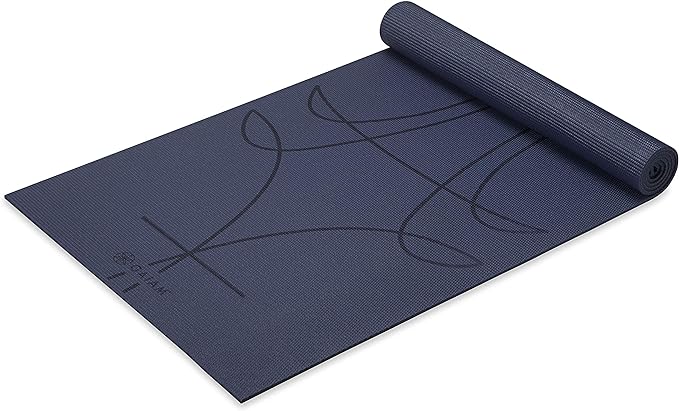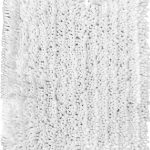As you begin your yoga journey, you’re likely to discover that a good yoga mat is more than just a luxury – it’s a necessity. You’ll want a mat that provides the right amount of grip, support, and comfort to enhance your practice. So, what sets the top-rated mats apart from the rest? Let’s take a closer look at three standout options: the Liforme Original, Gaiam Premium, and Hugger Mugger para Rubber mats. Each boasts unique features that cater to different needs, but which one will best align with your yoga style?
Contents
Liforme Original Yoga Mat
If you’re a serious yogi seeking a high-quality mat that provides unparalleled traction and alignment guidance, the Liforme Original Yoga Mat is an excellent choice, featuring its patented AlignForMe system and GripForMe material that prevents injuries and slipping.
You’ll appreciate the eco-friendly, sweat-resistant, and non-slip material that provides a comfortable 4.2mm thick practice.
The long and wide dimensions (72.83L x 26.77W x 0.17Th inches) provide ample space for your movements.
With over 2,679 ratings and a 4.7-star average, users rave about the grip, alignment system, and eco-friendliness.
You’ll enjoy improved weight distribution, proper form, and cushioning comfort during your practice, which helps to support and facilitate a safe and effective workout.
Best For: Serious yogis who prioritize traction, alignment, and eco-friendliness in their yoga practice.
Pros:
- Provides unparalleled traction and alignment guidance with its patented AlignForMe system and GripForMe material
- Eco-friendly, sweat-resistant, and non-slip material ensures a comfortable and safe practice
- Improves weight distribution, proper form, and cushioning comfort during practice
Cons:
- Hand wash only, which may be inconvenient for some users
- Some users may prefer to use their own bags instead of the included one
- May be more expensive than other yoga mats on the market
Gaiam Premium 6mm Print Yoga Mat
You’ll appreciate the Gaiam Premium 6mm Print Yoga Mat’s exceptional grip and support, making it an ideal choice for yogis who need extra cushioning and stability for their joints.
With its 6mm thick premium material, this mat provides excellent cushioning and support, facilitating a comfortable practice.
The textured, non-slip surface guarantees stable grip, even when you’re sweating.
You’ll also appreciate the alignment print design, which helps you maintain proper alignment and pose.
Available in various colors and styles, this mat isn’t only functional but also visually appealing.
With over 20,000 ratings and a 4.7-star rating, it’s clear that this mat has won the hearts of many yogis.
Best For: Those who need extra cushioning and stability for their joints, particularly individuals with joint issues or lupus.
Pros:
- Provides excellent cushioning and support for joints
- Non-slip surface ensures stable and comfortable practice
- Alignment print design helps with proper alignment and pose maintenance
Cons:
- Some users experience slipping with sweaty hands
- May have minor issues with odor and curling edges
- Grip can be improved by wetting the mat, but may not work for everyone
Hugger Mugger para Rubber Mat
With its superior, non-slip grip on both sides, the Hugger Mugger para Rubber Mat is an excellent choice for yogis who prioritize stability and traction in their practice.
You’ll appreciate the 1/4 thickness that provides excellent cushion and shock absorption, making it perfect for those intense yoga sessions.
The natural rubber material is durable, long-lasting, and eco-friendly, giving you peace of mind.
Measuring 70L x 24W x 0.25Th, this mat is spacious enough for you to move freely.
Although it’s a bit on the heavier side at 6 pounds, the pros outweigh the cons.
You’ll love the streaked black and white pattern, and the fact that it’s easy to maintain with a simple wipe-down and air dry.
Best For: Yogis who prioritize stability and traction in their practice, especially those who prefer a durable, eco-friendly, and spacious mat.
Pros:
- Perfect grip, cushion, and stability for intense yoga sessions
- Durable and long-lasting natural rubber material
- Eco-friendly and affordable option for yogis
Cons:
- Heavy weight of 6 pounds may be inconvenient for some users
- Initial strong rubber smell that may be unpleasant
- Minor issues with residue and drying time may require extra maintenance
Factors to Consider When Choosing a Yoga Mat
When you’re shopping for a yoga mat, you’ll want to think carefully about several key factors to guarantee you find the right one for your practice.
You’ll need to ponder the material and durability, as well as the grip and traction level, to guarantee you can maintain your poses with confidence.
Additionally, you’ll want to weigh the thickness and cushioning, eco-friendliness and safety, and size and portability to get the most out of your mat.
Material and Durability
As you set out to choose the perfect yoga mat, considering the material and durability is essential to guarantee a comfortable and sustainable practice.
You’ll want a mat that can withstand your frequent practices and provide the necessary support for your joints. Natural rubber is an excellent option, offering durability and longevity. It’s also eco-friendly, providing excellent grip and cushioning.
On the other hand, PVC material, although non-toxic and 6P free, may not be the best choice, as it can be prone to slipping with sweaty hands.
When it comes to thickness, a thicker mat (around 6mm) is a great option, providing more cushioning and support for your joints.
However, you should also consider the weight of the mat. A heavier mat (around 6 pounds) is more durable, but it may be less portable.
You’ll need to strike a balance between durability and portability, depending on your specific needs. By considering these factors, you’ll be able to find a yoga mat that meets your requirements and provides a comfortable and sustainable practice.
Grip and Traction Level
You need a yoga mat that can keep up with your sweatiest downward-facing dog, which is why grip and traction level are essential factors in selecting the perfect mat for your practice.
A good grip guarantees you can maintain your poses without slipping or sliding around, giving you the confidence to push yourself further. Look for mats with textured surfaces, ridges, or bumps that provide extra traction. Some mats even have special grip patterns or materials that help keep your hands and feet in place.
When evaluating grip and traction, consider your personal sweat level and the type of yoga you practice. If you’re a hot yoga enthusiast or tend to sweat a lot, you’ll want a mat with exceptional grip to prevent slipping.
On the other hand, if you practice gentle Hatha or Restorative yoga, you might prioritize comfort over grip. Ultimately, a mat with the right level of grip and traction will help you feel more secure and focused during your practice, allowing you to get the most out of your yoga sessions.
Thickness and Cushioning
Your grip and traction needs met, it’s time to weigh the comfort and support of your yoga mat, starting with its thickness and cushioning.
A thicker mat can provide more comfort for your joints, but it may come at the cost of portability and balance.
You’ll want to ponder a minimum of 4mm thickness for comfort and support, but some mats can be as thick as 6mm for extra cushioning.
If you have joint issues or practice more intense or dynamic styles of yoga, a thicker mat may be beneficial.
However, the ideal thickness ultimately depends on your personal preference, practice style, and the level of comfort and support you need.
Mats with extra cushioning can reduce pressure on your joints and provide a more comfortable practice, but they may not be suitable for more balance-focused practices.
Eco-Friendliness and Safety
What makes a yoga mat truly eco-friendly and safe for your practice, and how can you verify you’re getting a mat that meets these critical standards?
When choosing a yoga mat, look for eco-friendly materials like natural rubber, which provides a non-slip grip and is gentle on the environment. Additionally, opt for mats that are 6P free, meaning they don’t contain harmful phthalates that can harm your health and the environment.
A safe yoga mat should also have an alignment system printed on it, guiding you through your practice and preventing injuries. Furthermore, having excellent traction and grip, even when wet, is crucial to prevent slipping and falling.
To maintain your mat’s eco-friendliness, hand wash and air dry it to prevent the growth of bacteria and other microorganisms. You must also verify that your mat provides a non-slip surface, even when wet, to prevent accidents.
Size and Portability
Size and portability are essential considerations when selecting a yoga mat, as they directly impact your practice’s convenience and overall experience.
You’ll want a mat that’s easy to carry to and from class, yet still provides ample space for your practice. Most yoga mats come in standard sizes, ranging from 24′ to 28′ in width and 68′ to 72′ in length.
However, if you’re taller or prefer more space, look for larger mats or ones specifically designed for taller practitioners.
When it comes to portability, consider the mat’s weight, thickness, and storage options.
You’ll want a mat that’s lightweight and easy to roll up, with a carrying strap or bag for convenient transport. Some mats even come with a compact, foldable design, making them perfect for travel or storage.
Think about your yoga style and preferences – do you need a lot of grip or cushioning? Do you practice at home or in a studio?
Frequently Asked Questions
Can I Use a Yoga Mat on a Hardwood Floor?
You’re wondering if you can use a yoga mat on a hardwood floor. Absolutely! A good-quality yoga mat will provide enough grip and cushioning, allowing you to practice comfortably and safely on a hardwood floor.
Do Yoga Mats Come With a Carrying Strap?
“Are you ready to roll out and roll up with ease? You’ll be happy to know that many yoga mats do come with a carrying strap, making it a breeze for you to take your practice on-the-go!”
How Do I Clean My Yoga Mat After Use?
After each sweaty session, you’ll want to clean your mat to prevent bacteria buildup. Simply wipe it down with a damp cloth and mild soap, then dry it thoroughly to keep it fresh and hygienic.
Are Yoga Mats Suitable for Hot Yoga Practices?
When you’re sweating it out in hot yoga, you’ll need a mat that can keep up. Look for mats made from non-slip, sweat-resistant materials that can withstand high temperatures and intense humidity.
Can I Use a Yoga Mat Outdoors on Grass or Dirt?
Imagine practicing yoga on a serene grassy hill, surrounded by nature’s tranquility. Yes, you can use a yoga mat outdoors on grass or dirt, but choose a mat with a textured, non-slip surface and consider a waterproof or sweat-resistant option to maintain grip and durability.
Conclusion
It’s no coincidence that you’ve narrowed down your search to these high-quality yoga mats.
You’re probably looking for a mat that checks all the boxes – grip, support, alignment, and comfort.
The Liforme, Gaiam, and Hugger Mugger mats do just that.
Each offers unique features that cater to different needs and preferences.
Now that you’ve got the scoop, it’s time to choose the one that resonates with you.
Trust your instincts, and get ready to take your yoga practice to the next level!








